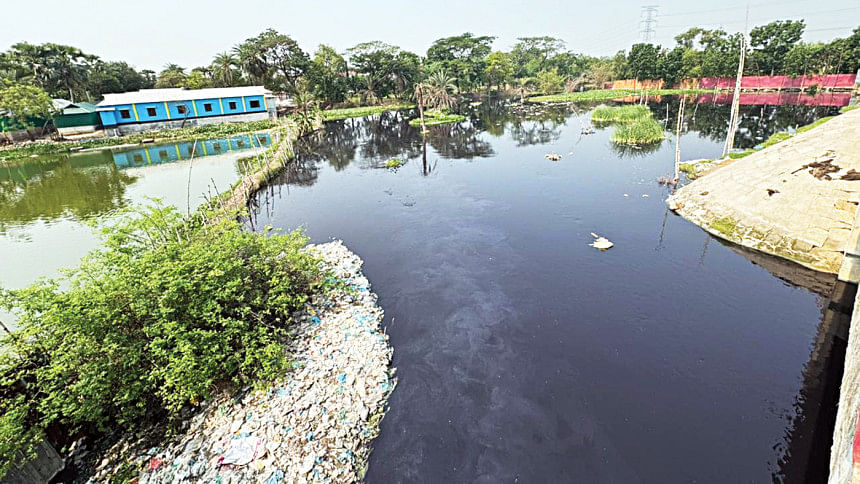Once a lifeline, Labondaho now a curse

Abdul Aziz once harvested rice in abundance from his fields next to Labondaho, once a picturesque river located in Indrapur, Gazipur's Sreepur. Today, he stands on cracked earth, nursing losses and lamenting poisoned waters.
This year, he invested Tk 18,000 in cultivation, expecting to reap 37 maunds (1 maund = 37.3242 kilogrammes) of paddy. Instead, he harvested only 21. "If the water wasn't so polluted, I could've met my target," he told The Daily Star.
Aziz farms on 35 decimals of land beside the river, now reduced to a narrow canal with stagnant water, choked with industrial waste and sewage. Locals no longer call it Labondaho, but Lobolong, the bitterness in their voices unmistakable.
We met Aziz just past a culvert on the road to the Gazipur Safari Park, a tourist trail that masks the silent crisis unfolding behind the treeline. For locals, the devastation is inescapable.
Aziz's neighbour, Matiur Rahman, fared even worse. His land, flooded with foul-smelling water, yielded just five maunds of rice since the embankment he made to save the land was breached.
The pollution of Labondaho has turned farming into a game of chance, one that farmers increasingly lose. Across at least 50 villages, including Kabarghata, Beltoli, Uttar Beltoli, Korotoa, Shibit Chala, Baniar Chala, Beraider Chala, Boirar Chala, Paillabandha, Pirujali, Bhanipur, Mirzapur and more, farmers share the same story. Fields either wither in drought or drown in toxic runoff. Yields plummet. Illnesses rise.
Locals and environmentalists estimate that hundreds of acres of farmland have become uncultivable due to persistent waterlogging and contamination.
Once the lifeblood of an agrarian economy, the Labondaho is now a cautionary tale of industrial recklessness. What was once a river is now a black, foul-smelling stream that poisons land, sickens families, and suffocates livelihoods.
According to the water resources ministry, the 29-kilometre-long Labondaho originates in Gazipur Sadar and empties into the Turag. But residents say it flows from the Khiru river in Bhaluka, Mymensingh, coursing through Maona Uttar Para, Maona Bazar, Gargaria Master Bari, Bagher Bazar, and the Indrapur Safari Park area before joining the Turag at Bhabanipur.
Pollution, locals say, began in the 1990s with the rapid rise of factories in Gazipur. And Labondaho isn't alone. The Tengra, Kata, Sera, Bairagirchala, Tarun, and Saldah canals have all suffered a similar fate.
Trucks routinely dump industrial waste beneath the bridge over the Labondaho river, near the Bagher Bazar–Safari Park route in Gazipur Sadar. The water has turned black, thick with stench. Residents say fish have vanished, and even livestock fall ill after contact.
Mohammad Asadullah of Chakpara village in Maona union said various indigenous fish species were once available in the river. "We used to cultivate our fields using its water," he said.
"We used to fish here and bathe in its water," said Ahmad Ali of Maona Uttar Para. "Now, using it causes diarrhoea and diseases even in animals."
Anwar Hossain of Beltali village said the land has become so polluted that even walking along the fields is difficult. "The soil is littered with polythene," he said. "Growing paddy is out of the question."
Mohammad Moazzem Hossain, a resident of Indrapur and an employee of a knit composite factory, lives beside the river. "The stench is unbearable," he said. "At day time, the stench is sickening. At night, the air turns toxic."
According to Industrial Police and factory sources, Gazipur houses 2,176 registered factories, 1,154 of them garments. In Sreepur alone, there are 674 factories, of which 657 have effluent treatment plants (ETPs).
But Deputy Director Arefin Badol of the Department of Environment (DoE) says some factories secretly release untreated effluents through underground pipes.
"When we visit the factories along with our lab team, we often find that the ETPs are turned on only when we are seen standing at the gate," he said. "We will take action."
He added that the DoE has discussed advanced surveillance, including drones and high-tech monitoring, with the director general. Seventeen factories have had their service connections cut, though some have resumed operations via court orders. Legal action is ongoing against two others.
Environmentalists say enforcement has long lagged behind violations. Khorshed Alam, chairman of River and Nature Foundation, said industrial waste has blocked the river's flow, worsening pollution. "Farmers can no longer step into their land, let alone farm it," he said. "Immediate excavation and cleanup are crucial to stop the farmers from facing losses."
Sharif Jamil, representative of Waterkeeper Bangladesh, echoed this warning: "Labondaho is just one of many. Untreated waste from textile and tannery industries, even by government bodies like city corporations and WASA, have made Dhaka's rivers toxic."
He said pollution upstream, from Gazipur's textile industries and even from the Khiru river at Bhaluka in Mymensingh, contributes to widespread contamination downstream in rivers like the Turag in Dhaka.
Mahmud Hasan Khan, president-elect of the Bangladesh Garment Manufacturers and Exporters Association (BGMEA), acknowledged the industry's role. "Pollution isn't confined to Gazipur," he said.
"Installing CCTV in industrial zones to monitor ETPs could be a step forward. Vigilance must be increased," he said, adding that other bodies like Bangladesh Textile Mills Association and Bangladesh Knitwear Manufacturers and Exporters Association should also come forward to protect the environment.
Syeda Rizwana Hasan, adviser to the Ministry of Environment, Forest and Climate Change, said the government has taken protection of the Labondaho river as a new initiative being financed under the Climate Change Trust Fund.
"We will demarcate the river's boundary, remove encroachments, carry out dredging, and complete the excavation work," she said.
The ministry's secretary and the DoE chief met with industries responsible for the pollution and warned them to cease operations like occupying and polluting that harm the river.
"Dumping waste became habitual due to years of inaction despite continuous pollution. These industries have been initially served notices and were engaged in meetings. They are now being brought under strict monitoring and control. Simultaneously, we will also begin enforcement actions.
She noted the department has only six magistrates. Much of the winter was spent shutting down illegal brick kilns.
"Now, we are prioritising and focusing on industrial pollution. We hope to begin our operations to save the Turag river in Dhaka by November or December," she said.
"If we cannot free Loblong from pollution, it will be impossible to save the Turag."

 For all latest news, follow The Daily Star's Google News channel.
For all latest news, follow The Daily Star's Google News channel. 


Comments